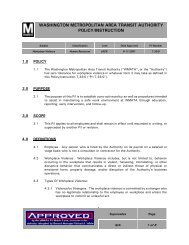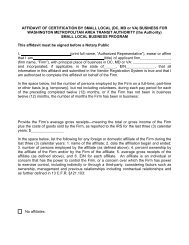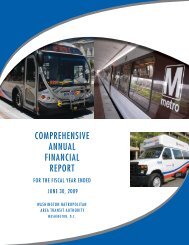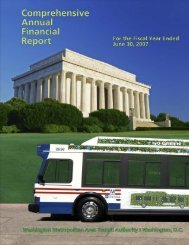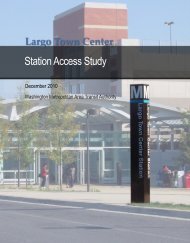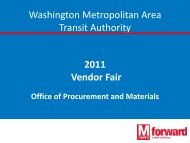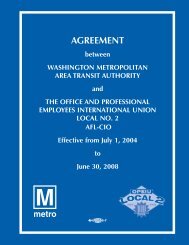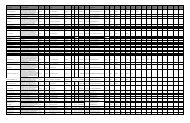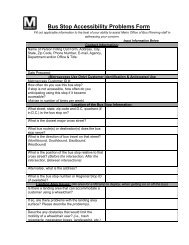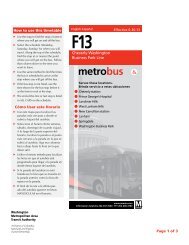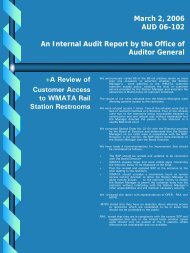Naylor Road Metro Station Area Access and Capacity - WMATA.com.
Naylor Road Metro Station Area Access and Capacity - WMATA.com.
Naylor Road Metro Station Area Access and Capacity - WMATA.com.
You also want an ePaper? Increase the reach of your titles
YUMPU automatically turns print PDFs into web optimized ePapers that Google loves.
plans will also need to be taken into account inasmuch as the street grid created may present<br />
other “unofficial” locations for Kiss & Ride activity to take place, such as street curbsides free of<br />
parked cars during peak hours.<br />
Park & Ride<br />
Parking at <strong>Naylor</strong> <strong>Road</strong> <strong>Station</strong> is constrained. The station’s single Park & Ride surface lot<br />
contains 368 daily parking spaces, which represents only five percent of all available parking<br />
on the southern Green Line (Southern Avenue <strong>Station</strong>, <strong>Naylor</strong> <strong>Road</strong> <strong>Station</strong>, Suitl<strong>and</strong> <strong>Station</strong>,<br />
<strong>and</strong> Branch Avenue <strong>Station</strong>). Daily parking will very likely remain constrained into the future<br />
given the expected redevelopment of the station area into a transit-oriented regional center that<br />
emphasizes pedestrian <strong>and</strong> bicycle access.<br />
This study utilized the MWCOG travel dem<strong>and</strong> model to estimate the magnitude of 2040<br />
parking dem<strong>and</strong> by assuming <strong>Naylor</strong> <strong>Road</strong> <strong>Station</strong> parking is unconstrained. Such an analysis<br />
helps <strong>Metro</strong> underst<strong>and</strong> the imbalance between parking supply <strong>and</strong> dem<strong>and</strong>. The results of<br />
this analysis showed that, in an unconstrained parking scenario, daily parking dem<strong>and</strong> would<br />
be reduced at both Suitl<strong>and</strong> <strong>Station</strong> <strong>and</strong> Branch Avenue <strong>Station</strong> <strong>and</strong> increased for <strong>Naylor</strong> <strong>Road</strong><br />
<strong>Station</strong>, most likely because <strong>Naylor</strong><br />
Table 20: Unconstrained Parking Dem<strong>and</strong> at <strong>Naylor</strong> <strong>Road</strong> <strong>Station</strong><br />
2040 Peak Period Park & Ride<br />
Dem<strong>and</strong>*<br />
Constrained Unconstrained<br />
<strong>Station</strong><br />
Parking<br />
Scenario<br />
Parking<br />
Scenario<br />
Total<br />
Difference<br />
Percent<br />
Difference<br />
<strong>Naylor</strong> <strong>Road</strong> 646 2,325 +1,679 +260%<br />
Suitl<strong>and</strong> 3,462 2,862 -600 -17%<br />
Branch Avenue 5,035 4,534 -501 -10%<br />
Source: MWCOG travel dem<strong>and</strong> model<br />
* These numbers represent the number of desired parking trips in 2040, not the number of<br />
parking spaces. The number of desired trips can be higher than the number of spaces due to<br />
turnover.<br />
<strong>Road</strong> <strong>Station</strong> is closer to the District<br />
<strong>and</strong> would thus save time for daily<br />
<strong>com</strong>muters. The analysis found that<br />
2040 Park & Ride trips to <strong>Naylor</strong> <strong>Road</strong><br />
<strong>Station</strong> would increase by 260 percent<br />
if parking were unconstrained, as<br />
shown in Table 20. If trying to meet<br />
this dem<strong>and</strong>, <strong>Metro</strong> would need a Park<br />
& Ride facility of approximately 2,325<br />
daily spaces, assuming an average<br />
occupancy rate is 1.04 people per<br />
vehicle.<br />
Significantly increasing the amount of Park & Ride spaces at <strong>Naylor</strong> <strong>Road</strong> <strong>Station</strong> to such a<br />
degree, however, does not conform to <strong>Metro</strong>’s, Prince George’s County’s, or Maryl<strong>and</strong>’s vision<br />
for the station area. The vision for a redeveloped <strong>Naylor</strong> <strong>Road</strong> <strong>Station</strong> emphasizes alternative<br />
modes of access, such as walking, cycling, <strong>and</strong> bus services, <strong>and</strong> the high capital cost of<br />
providing enough parking to meet dem<strong>and</strong> throughout the <strong>Metro</strong>rail system has similarly<br />
prompted <strong>Metro</strong> to focus on promoting these modes of access, which have lower capital costs.<br />
Even the constrained scenario shows parking dem<strong>and</strong> well over the existing parking capacity<br />
of <strong>Naylor</strong> <strong>Road</strong> <strong>Station</strong>, likely due to reuse of spaces <strong>and</strong> overflow parking inherent in current<br />
parking utilization data.<br />
<strong>Station</strong> <strong>Capacity</strong> & Emergency Egress<br />
Infrastructure requirements were evaluated with a station capacity analysis based on 2012 <strong>and</strong><br />
estimated 2040 ridership levels <strong>and</strong> requirements set by <strong>Metro</strong> <strong>and</strong> the Transit <strong>Capacity</strong> <strong>and</strong><br />
Quality of Service Manual. This analysis established the minimum required vertical (e.g. elevators<br />
<strong>Naylor</strong> <strong>Road</strong> <strong>Metro</strong> <strong>Station</strong> <strong>Area</strong> <strong>Access</strong> <strong>and</strong> <strong>Capacity</strong> Study | 48





